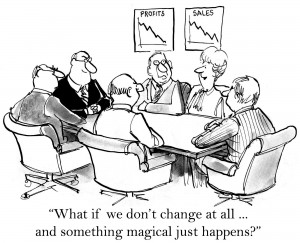Why CEOs Should Own Employer Branding Efforts

First Things First: Whose Job Is Employer Branding, Anyway?
Right off the bat in Universum’s study, we run into a problem: CEOs and HR pros can’t seem to agree on who is responsible for owning employer branding efforts in the first place.
“When asked: ‘Who has primary accountability for employer branding activities?’ the gap between CEOs’ and talent executives’ opinions is unsettling,” the study says.
Sixty percent of CEOs feel that employer branding is their job, whereas 58 percent of HR executives, 63 percent of talent acquisition executives, and 57 percent of recruiting executives all believe that HR should own the employer branding process.
“A lot of the uncertainty [about who owns] employer branding can often be attributed to how well those organizations understand the impact [employer branding] can have on business performance and, at the end of the day, the bottom line,” says Mike Parsons, marketing direct for the Asia-Pacific region at Universum.
Parsons believes that, when businesses have witnessed firsthand the competitive advantage that a strong employer brand can bring them in the talent market, then they are more inclined to “treat their [employer brands] as business strategies.” When businesses treat their employer brands as business strategies, they are more likely to start the conversation about employer branding with the C-suite.
So, does that mean CEOs — not HR dpartments — should be in charge of employer branding efforts?
Jaokim Strom, managing director for the Asia-Pacific region at Universum, says yes. But, Strom notes, this doesn’t mean HR should be cut out of employer branding entirely:
“Due to its strategic nature, I believe that CEOs should own the employer brand and drive the implementation together with HR, corporate communications, and marketing. We have seen that C-level involvement is crucial for any employer branding strategy to be accepted among employees. Also, having the C-suite as ambassadors will definitely secure a faster ROI.”
CEOs Have Been Slow to Take Action
So, most CEOs (60 percent
What an odd situation the CEOs find themselves in: they know employer branding is important for recruiting and retaining top talent; they know they should own employer branding processes; and yet, they aren’t doing anything to improve their employer branding strategies.
Parsons believes the CEOs’ paralysis in the face of employer branding can be attributed to the rapid rate at which the business world is changing today.
“A lot of CEOs and CHROs have been caught [off guard] by the pace at which the business landscape is evolving,” Parsons says. “[For example], roles that focus on things like social media and big data didn’t exist a few years ago, but are already becoming business critical.”
Essentially, Parsons means to say that CEOs can’t quite figure out where to even start. As the landscape around them evolves, they’re having a hard time finding any solid ground on which to place their feet.
Parsons also notes that the skills gap contributes to CEOs’ lack of action: many of them are struggling to find the right people with the right skills to help them implement better employer branding strategies.
A Unified Brand? Consumer and Employer Brands Begin to Merge
According to a study from LinkedIn Talent Solutions and Lippincott, companies are beginning to see benefits to aligning their employer brands with their consumer brands. Indeed, the LinkedIn/Lippincott study found that companies with strong employer and consumer brands saw “36 percent cumulative growth in shareholder value over five years,” compared to companies with strong consumer/weak employer brands (28 percent growth) and weak consumer/strong employer brands (1o percent growth).
Universum found that relatively few companies (19 percent) say their employer and consumer brands are “perfectly aligned,” but the firm also found that “nearly 30 percent [of companies] aim to achieve that objective [of perfectly aligned consumer and employer brands] over the next five years.”
Overall, the people behind Universum’s study believe that more unified consumer/employer brands are a good idea.

But, Focardi says, companies that don’t have strong consumer brands need not worry — they haven’t lost the war for talent just yet.
“Companies that have less well-known consumer brands have to work harder to build awareness of their employer brands,” Focardi says. “However they, are also more able to start from a clearer slate and shape perceptions more strategically — which, if done well, can give them an advantage over their better-known talent competitors.”
We raised a lot of questions in this post, but we didn’t offer too many answers, did we? Next time, we’ll start talking about solutions to the challenges organizations face when we tackle “Employer Brand Misalignment,” part two of Universum’s study.

